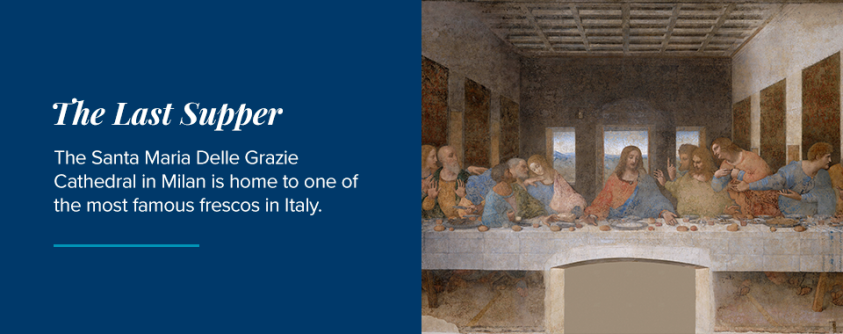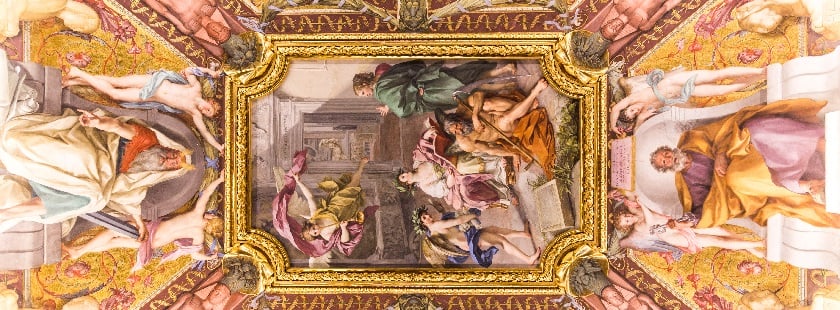
Italy is abundant with amazing art from throughout its history. You’ll see nearly countless frescos as you explore the country’s museums, churches and historical sites. These paintings involve artists painting directly on plaster walls. Several famous artists practiced this technique, including Leonardo da Vinci and Michelangelo.
When planning your trip to this beautiful country, add these locations to your itinerary to see the best frescos in Italy.
In This Article
1. The Room of the Masks in Rome
While many people associate frescos with the Renaissance, they existed long before that. The ancient Romans loved decorating their homes with fresco paintings depicting various scenes. These frescoes commonly show the countryside and buildings, representing life as the Romans lived. Visiting some ancient Roman frescos is a perfect way to dive into history.
The Houses of Augustus and Livia are the homes of the ancient Roman emperor and his wife. Located on Palatine Hill, you can access it with most tours of the Roman Forum. While perusing the house’s various rooms offers many frescos to explore, the Room of the Masks is one of the best available. This room depicts a traditional Roman theater with dramatic masks showing comedy and tragedy. It is full of stunningly preserved scarlets and gives visitors insight into the Roman lifestyle.
2. “The Allegory of Good and Bad Government” in Siena
You can find another lesser-known fresco in the Palazzo Pubblico in the center of Siena. This early Renaissance fresco is unique because it depicts Italian society and its values through how it believed governments should act. While many scenes from this period focus on Christianity and episodes from the Bible, this fresco takes a more social and political stance, giving viewers an insight into what Siena might have been like during this period.
The old town hall is full of beautiful bright blue, preserved well despite its age. You can spend lots of time exploring the various images because this fresco covers all walls and includes several details.
3. “The Nativity of Mary” in Florence
You can find the Tornabuoni Chapel in the Santa Maria Novella church in Florence. The frescos here are comprehensive, spanning from floor to ceiling. While artist Domenico Ghirlando led the commission, he worked with apprentices from his workshop to complete the project, including a young Michelangelo.
“The Nativity of Mary” portrays the birth of Mary, the mother of Christ, in a setting contemporary to the painter. Noble women gather around the mother and infant to welcome and congratulate them. The scene is full of exquisite details, helping individuals understand what Renaissance life was like, illustrating several types of furniture, clothes and hairstyles.
4. “The Sermon of the Antichrist” in Orvietto
Located in the Duomo of Orvieto, you can find Luca Signorelli’s depiction of The Last Judgement. Art historians believe these scenes heavily influenced Michelangelo’s later work on the Sistine Chapel. The Sermon of the Antichrist is a famous scene depicting the end of days, featuring the antichrist in the foreground with a demon telling him what to say.
People love this fresco because its bright, vibrant colors and unique color schemes imitate modern pieces, like movies and comic books. The paintings are well-preserved, making them seem like Signorelli only finished working on them yesterday. Signorelli is a master at exaggerated emotion and movements, bringing more life and realism to his work. Observers can understand what each individual is going through in this New Testament painting.
5. “The Expulsion of Joachim From the Temple” in Padua
The Scrovegni Chapel shows some of the earliest works of Florence painter Giotto. Many art historians use this chapel as a reference to identify his other works. Upon entering this chapel, you will notice the stunning blue contrasted by lots of gold.
The chapel contains many New Testament cycles and episodes. It starts with Joachim, Mary’s father, being cast out from the Temple. Giotto marks the subject with a golden halo so he stands out from the other priests. This scene perfectly encapsulates the human emotion behind the event, with Joachim’s face contorted with sorrow. The priest casting him out has a hand on his shoulder, highlighting the familiarity between the two and showing Giotto’s mastery of interactions.
6. The Piccolomini Library in Siena
After visiting the Palazzo Pubblico in Siena, head over to the town’s Duomo to find these fantastic frescos preserved in its library. The Piccolomini family commissioned these paintings to celebrate their accomplishments and the family members who served in the church. Several artists contributed to the frescos as later family members continued adding to the library’s art, including Michelangelo and Pinturicchio.
The library is full of reds, yellows and greens, overflowing with color when you enter. You can spend time exploring the various stories and episodes painted on the walls. If you want to see more Renaissant art, the library is also home to a collection of illuminated manuscripts.
7. “The Last Supper” in Milan

The Santa Maria Delle Grazie Cathedral in Milan is home to one of the most famous frescos in Italy. Here, Leonardo da Vinci’s depiction of the Last Supper shows all the disciples seated around a table, reacting as Christ tells them someone will betray him. This fresco showcases da Vinci’s ability to depict emotions, with each disciple wearing a unique facial expression.
This fresco also makes history by introducing a new painting technique. Artists usually painted frescos on wet plaster, but da Vinci moved slower than others, causing it to dry before he finished his work. Because of this, he decided to forgo painting on wet plaster and keep it dry, inventing the fresco secco technique, which means dry fresco.
8. “The Creation of Adam” in Vatican City
While technically located in Vatican City and museums, the ceiling of the Sistine Chapel is a must-see when exploring Italy’s best frescos. This work is a Michelangelo masterpiece, depicting various Bible scenes. The Creation of Adam is one of the most sought frescos, showing the first man reaching out to God as he receives life from the heavens.
Upon entering the chapel, you can find this fresco nestled amongst other important creation stories on the ceiling. Visitors continue to be in awe of Michelangelo’s use of color and mastery of anatomy in God and Adam’s figures.
9. “The Last Judgement” in Vatican City
Before leaving the Sistine Chapel, you should also take time to admire Michelangelo’s representation of The Last Judgement, which takes up a whole wall. The fresco tells the story of the second coming of Christ and His judgment of humanity. Throughout the fresco, you can see various figures engaging with the heavens and demons rising from Hell.
This colorful and detailed fresco invites visitors to stand and take in all the imagery and figures, observing Michelangelo’s mastery of the human form and emotion.
Explore Italian Art With Windstar Cruises
Italy is full of culture and art from periods throughout its history. When you’re ready to see it for yourself, you can trust Windstar Cruises to help you make the most of your trip through this Mediterranean country.
Our yacht cruises provide a unique take on travel, providing premier services and exciting adventures to create a more intimate experience. You’ll have a chance to get to know your staff and travel companions and the smaller ship size allows us to dock more places and explore everything Italy offers. You can also book our planned excursions to have us lead you through tours, tastings and more.
Find a cruise today and start planning your adventure to Italy with Windstar Cruises.


